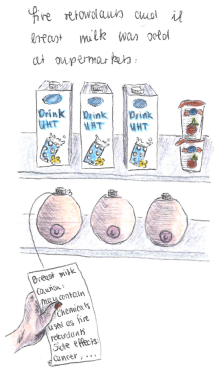Author: Frei Michèle Patricia
Accidental inflammation in dwelling houses is the cause of 11’00 fires every year in the EU and Norway with 520 deaths and 1’600 injuries. Therefore, flame retardants are added to a wide range of products, including furniture, electronics, and building materials, to make them less likely to catch fire. They act either as a barrier between flame and foam, or by limiting oxygen supply to fire. While in 1975 California approved a regulation that made the use of flame retardants in furniture foam mandatory, today there is discussion about the health effects of these chemicals and attempts are being made to reduce their use in everyday items.
According to the American Home Furnishings Alliance, more than 80 percent of furniture sold in the United States contain foam treated with flame retardant chemicals. And to make foam fire-resistant, it takes quite a bit of it; about 1 kg of chemicals is needed for a sofa alone. Due to off-gassing these chemicals have been found to accumulate in household dusk as well as in human blood and breast milk.
While the risks associated with flame retardants vary depending on the specific type of chemical and the level of exposure, the associated health effects are concerning. One of the most significant health risk associated to flame retardants is cancer. Furthermore, flame retardants have also been linked to diabetes, adverse effects on child development and alteration in thyroid function as well as a range of reproductive issues such as reduced fertility.

Regarding all these health risks, California has updated the regulation passed in 1975. Since 2013, furniture manufacturers are allowed to meet the standards without the use of flame retardants. However it does not prohibit the use of them. And in 2020 another progress has been made which prohibits the sale or distribution of new products used by babies and children under the age of 12 years, mattresses and upholstered furniture that contain a designated flame retardant over 1’000 ppm. Especially children should be protected since they are more vulnerable to toxic effects because their brains and other organs are still developing.
In Europe there have been similar movements in order to get away from these toxic chemicals. In 2022, the use of halogenated (bromine and chlorine) flame retardants (HFRs) used in electronic displays got banned. This should not only improve the indoor air quality, but should also improve the recycling of plastic parts of televisions and monitors. It is currently not possible to distinguish halogenated components from plastics derived from safer sources. Therefore dangerous HRFs can be found in recycled plastic in children’s toys, kitchen equipment and other household items.
There has also been a discussion if flame retardants actually prevent fires. According to Donald Lucas, a flammability scientist at Lawrence Berkley National Lab, there is no evidence that the fire retardants reduce fires significantly. This is mostly due to the fact that the regulation (from 1975, California) doesn’t say anything about the fabric, only the foam (filling) and since the fire does not start inside the sofa; the fabric is going to burn anyway.
Furthermore, a major cause of injury and death during a fire is the inhalation of toxic gases produced from burning materials. According to death certificates dated between 1979 and 2007 in the United Kingdom, there was one death from burns for eight inhalation deaths. Main sources of these toxic gases in homes are furniture, electronics and many other products containing brominated flame retardants. During combustion these toxins are released resulting in high concentrations in the air.
Special fabrics or fire barriers between the fabric and the foam allow us to make furniture fire resisting without using the toxic chemicals that have been used so far.
https://www.bdlaw.com/publications/california-enacts-broad-prohibitions-on-flame-retardant-use/
https://www.npr.org/2012/05/23/153308887/fight-over-flame-retardants-in-furniture-heats-up
https://www.sciencedirect.com/science/article/pii/S0379711209000459